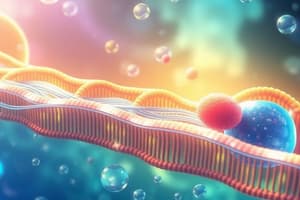Podcast
Questions and Answers
What is active transport?
What is active transport?
- Movement of substances with a concentration gradient
- Movement of substances against a concentration gradient using energy (correct)
- Passive movement of water
- None of the above
How does active transport differ from diffusion and osmosis?
How does active transport differ from diffusion and osmosis?
Active transport goes against the concentration gradient, while diffusion and osmosis travel with the gradient.
Why does active transport require energy?
Why does active transport require energy?
It requires energy to work against a concentration gradient.
Why is active transport important for plants?
Why is active transport important for plants?
How does active transport benefit the human body?
How does active transport benefit the human body?
Why is active transport vital for marine birds and reptiles?
Why is active transport vital for marine birds and reptiles?
Why is cyanide considered an effective poison?
Why is cyanide considered an effective poison?
Flashcards are hidden until you start studying
Study Notes
Active Transport Overview
- Active transport involves moving substances against their concentration gradient, requiring energy input.
- Movement occurs from areas of low concentration to high concentration across cell membranes.
Comparison with Diffusion and Osmosis
- Distinct from diffusion and osmosis, which move substances down their concentration gradients (high to low).
- Active transport necessitates energy, making it a unique process essential for various biological functions.
Energy Requirements and Source
- Energy for active transport is derived from respiration, facilitated by mitochondria within the cell.
- The relationship between respiration rate and active transport rate emphasizes the energetic demands of this process.
Importance for Plants
- Plants absorb mineral ions from dilute soil solutions using active transport, crucial for nutrient uptake.
- This mechanism allows plants to maintain necessary concentration levels for growth and development.
Role in the Human Body
- Active transport is essential for glucose absorption in the kidneys, moving glucose against its concentration gradient into the bloodstream.
- This process is vital for maintaining energy levels and overall metabolism.
Significance for Marine Birds and Reptiles
- Marine species face challenges with salt intake from seawater; active transport regulates sodium ion levels.
- Special glands near the eyes and nostrils expel excess salt, highlighting the necessity of active transport in osmoregulation.
Impact of Cyanide as a Poison
- Cyanide disrupts mitochondrial respiration, halting energy production vital for active transport.
- The inability to perform active transport leads to harmful physiological consequences, emphasizing the role of energy in cellular functions.
Studying That Suits You
Use AI to generate personalized quizzes and flashcards to suit your learning preferences.



